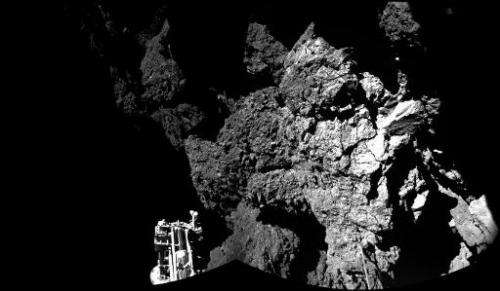Wake up Philae! The world awaits news (Update)

Excitement mounted Thursday as scientists started listening for signs of life from robot lab Philae, hurtling through space perched on a comet some 460 million kilometres (285 million miles) from Earth.
Messages of encouragement used the Twitter hashtag #WakeUpPhilae, as a long-awaited communications window between Earth and the washing machine-sized probe opened at 0100 GMT—exactly four months after it arrived at its new home.
But Philae gave no immediate response, the European Space Agency (ESA) said, and cautioned there could be a long wait before the lander talks to its comet-orbiting mothership Rosetta... if at all.
"We are just trying," Rosetta mission manager Patrick Martin told AFP by telephone.
After four months with no news from Philae, the probe's position relative to Rosetta and the Sun was expected to offer the first real possibility for contact in a window from March 12 to 20.
"And we will try again if it doesn't work this week. We will have more opportunities in the weeks and months to come," said Martin.
Philae touched down on Comet 67P/Churyumov-Gerasimenko on November 12 after a seven-hour, 20-km descent from Rosetta, which had travelled more than a decade and 6.5 billion kilometres to enter the dusty iceball's orbit in August last year.
But the landing did not go smoothly.
The probe, which weighs 100 kilogrammes (220 pounds) on Earth but less than a feather in the comet's weak gravity, bounced twice off the hard surface before settling at an angle in a dark ditch.
Philae had enough stored battery power for 60 hours of experiments. It sent home reams of precious data before going into standby mode on November 15.
As comet "67P" draws closer to the Sun, it is hoped better light conditions will recharge Philae's solar-powered batteries enough for it to wake up, make contact, and start a new series of experiments.
Excited!
But the probe's exact position is not known, nor whether it can be reached by the Sun's rays.
On the ESA mission's twitter page, Rosetta declared itself "Excited!".
"opportunities to listen for @philae2014 to find out if he's awake!" the mothership said, with a cute cartoon-drawing version of the probe sleeping peacefully under a green blanket at the foot of a cliff.
Messages from followers included: "Wakeup buddy!" and "it's time for work now!!"
ESA said there will be 11 optimum slots for signal transmission during this nine-day window—roughly two periods per day when the orbiter, lander and Sun are best aligned.
Though it "could happen", Martin said he and the team "do not expect it (Philae) to wake up this week."
The likelier chance may actually be around May, June or July, he added, as comet "67P" and its precious cargo edge ever closer to the Sun.
"The difficulty is whether it has enough energy first to wake up and then to communicate with Rosetta," said Martin.
Comet "67P" is expected to reach its closest point to the Sun, at a distance of 186 million kilometres (116 million miles), on August 13.
The lander's interior must reach at least minus 45 degrees Celsius (minus 49 degrees Fahrenheit) and generate 5.5 watts with its solar panels to wake up, according to ESA's Rosetta blog.
The temperatures at Philae's landing site are "significantly lower" than at the target location.
The robot lab has 10 instruments on board, including a drill, chemistry sets and imaging tools.
It is the crowning feat in a 1.3-billion-euro ($1.4-billion) mission to unlock the secrets of comets, which some astrophysicists believe may have "seeded" Earth with some of the ingredients for life.
An animated ESA video of Rosetta and Philae's exploits can be viewed below:
© 2015 AFP





















